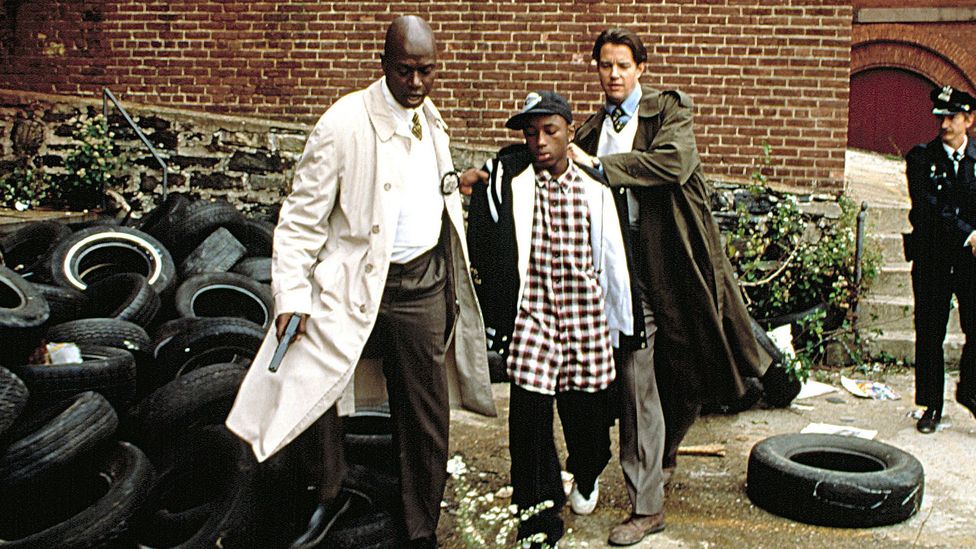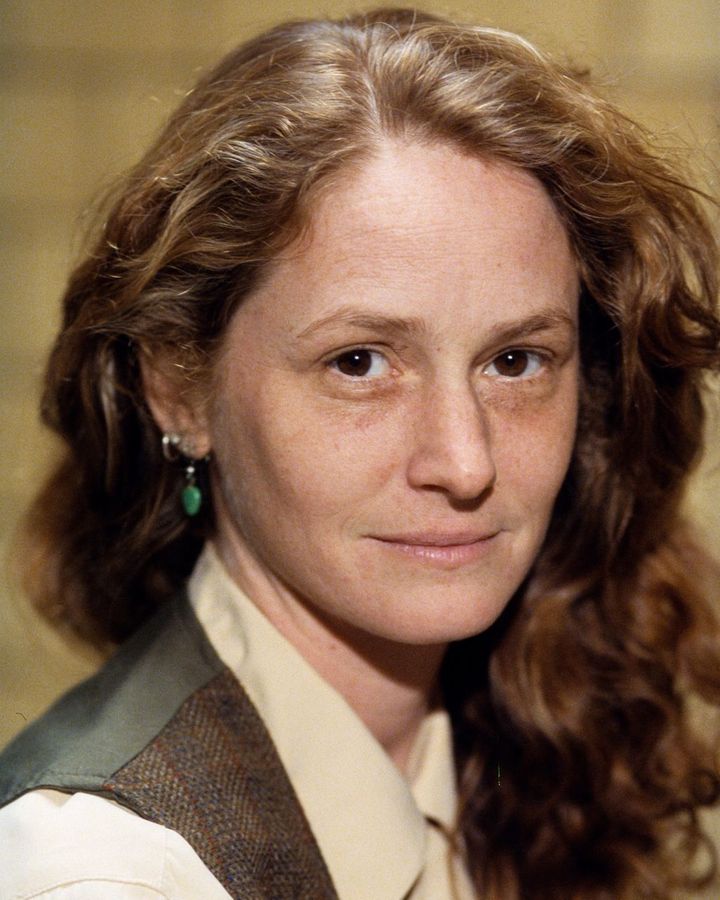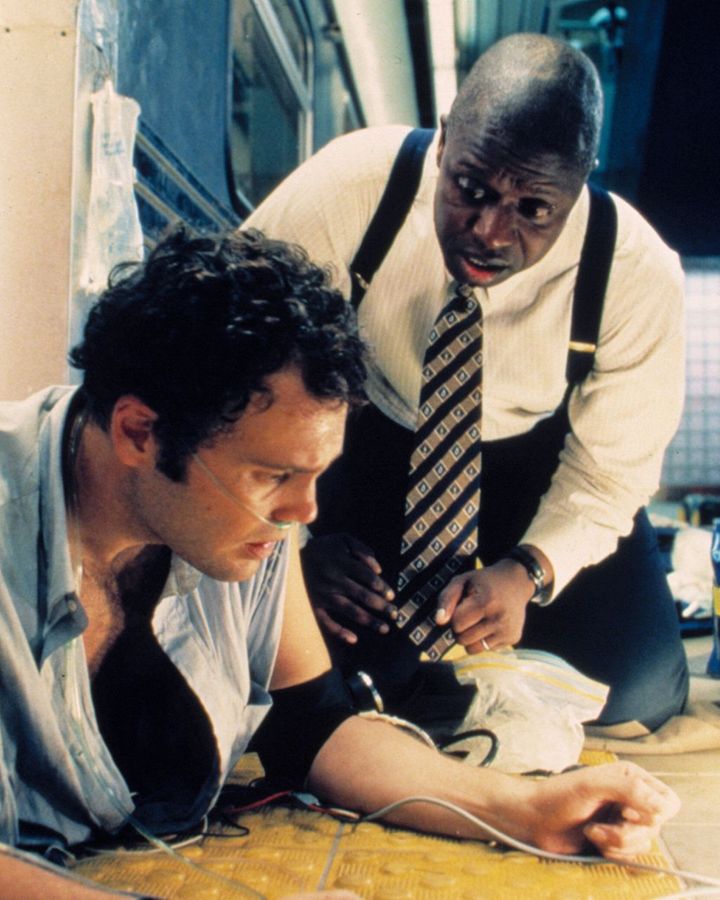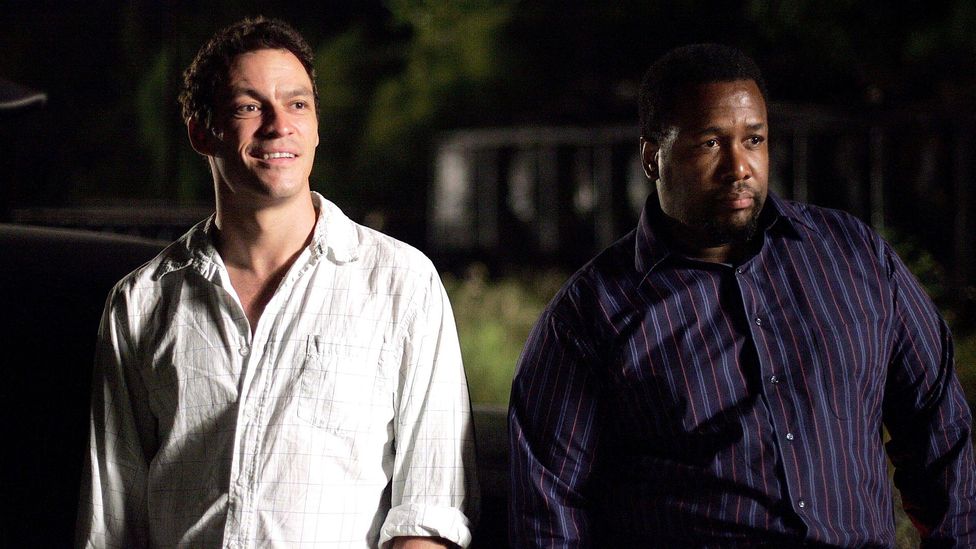The 90s cop show that changed TV

When the first episode of Homicide: Life on the Street aired on US network NBC on 31st January 1993, the crime drama looked like very little on TV at the time.
More like this:
– Why The Wire is the 21st Century’s greatest TV show
– What is the future of the cop drama?
– The best TV shows to watch in January
The series was based on David Simon’s book Homicide: A Year on the Killing Streets which documented his time spent with the homicide unit of Baltimore Police Department; Simon would go on to create The Wire, still regarded as one of the best TV dramas ever made, but having started his career as a reporter, he made his name with this vividly written account of his time shadowing a shift of homicide detectives in 1988 as they investigated murders. As with his book, the show captured the day-to-day reality and often grim humour of a group of people whose job puts them in regular proximity with death.

The series showed the day-to-day reality of the work of Baltimore homicide detectives, failings, corruption and all (Credit: Alamy)
The Wire is rightly considered a high watermark for television, but its mixture of compassionate storytelling and social critique was already evident in Homicide – which marks its 30th anniversary this month. Though Simon’s creative involvement with the show was limited, his reporting provided the inspiration. In addition to the Baltimore location, the two shows shared some of the same actors and crew, and even recycled some scenes from Simon’s book – an incident when cops convince a gullible suspect that a photocopier is a polygraph is repeated in both shows.
The show was initially shot on Super 16mm with handheld cameras, creating a rough, yet propulsive visual style, peppered with distinctive jump cuts. Even the grainy black-and-white opening credits marked the show apart. Most police procedurals at the time had a more polished look.
When Barry Levinson, director of Diner (1982) and Good Morning, Vietnam (1987), approached writer and producer Tom Fontana – who had a background in television and theatre – to help him bring the book to the screen, he told him he wanted to do a cop show with no car chases and gun battles. “It seemed like such a crazy idea, such a challenge, that I totally embraced it,” says Fontana.
Homicide strove to be authentic. It was shot on location in Baltimore and the city, its harbour, rowhouses and corners would become an integral part of the show. The detectives in Simon’s book were on-hand to provide advice. “We learned a lot from those fellows,” says Melissa Leo, who played detective Kay Howard, and would later win an Oscar for her role in David O’Russell’s The Fighter. Early on Simon took the cast to visit various drug hangouts around the city, recalls Kyle Secor, who played rookie detective Tim Bayliss. Even the filing cabinets in the squad room were filled with old police reports. The police department was being computerised, so the set designer was able to acquire them.
The cops In Homicide rarely drew their guns. They kvetched about the paperwork and the air conditioning. They fretted over their clearance rates and the number of unsolved cases listed under their name in red on the board that featured prominently in each episode. The dialogue combined musings on life and death, with digressions about the Lincoln assassination and which animal produces the biggest sperm. The characters prided themselves in the show on “speaking for the dead” but they were all complex and flawed. “This is a group of people who, every day of their lives, are dealing with dead bodies. You have to acknowledge the effect of that on them emotionally, spiritually, mentally,” says Fontana.
The central line-up
The eclectic cast featured experienced character actors – including Yaphet Kotto, known for the likes of Alien and Live and Let Die, and Ned Beatty, star of Network and Deliverance – alongside comedian Richard Belzer, as the acerbic John Munch (a character he would go on to play in several seasons of another NBC procedural, Law and Order SVU). Clark Johnson, who played the affable Meldrick Lewis, would go on to direct the opening episodes of both The Shield and The Wire, shaping the feel of the police drama of the next decade. Altogether, the ensemble was also notably ethnically diverse for the time.

Future Oscar-winner Melissa Leo played Kay Howard, the only female cop in the unit (Credit: Alamy)
More retrograde was the fact that the central line-up of detectives was initially going to be all-male, until Fontana and Levinson thought better of it, explains Leo. She landed the role of Howard, the only female cop in the Homicide unit. While many of the characters had direct parallels in Simon’s book, this was not the case with Howard. Female detectives were rare. There wasn’t a precedent for her, says Leo. The character was initially going to be called Kay Harvey, in a nod to Rick Garvey, one of the real-life detectives, who just like Howard had a perfect closure rate, but they decided against this as it was felt Garvey “could not possibly return to his workstation once he found out a girl was playing him,” laughs Leo.
Leo was keen to avoid portraying her in a cliched way. Howard was diligent, ambitious and highly professional, more competent than her male partner. There were also no rules about what a female detective should wear, she explains, “so we invented it”. Howard often wore a shirt and tie, she says, “something I think is becoming on a woman – which is finally being understood”.
While it was an ensemble show, Andre Braugher, who played Detective Frank Pembleton, an erudite, Jesuit-educated New Yorker with a complicated relationship with God, rapidly established himself as a standout. He had an electrifying screen presence, radiating charisma and energy. “I had never seen an actor like that on television,” says Fontana. “His rhythms were so unique to him.”
Secor’s character, Bayliss, was thrown into the deep end on his very first case, the murder of Adena Watson, an 11-year-old girl – based on the real-life murder of LaTonya Wallace, one of the most upsetting cases in Simon’s book. The detective in charge of the Wallace murder was there when they filmed many of those scenes. “It had a huge impact on his life, his relationships, and on the way that he approached his work,” says Secor, something which informed the character of Bayliss.
“Bayliss had a very high standard in terms of what was right and what was wrong,” says Secor. Bayliss’ partnership with the formidable Pembleton developed over the series. “Andre was the greatest partner in the world,” says Secor. “We saw ourselves as an old married couple.” Frequently filming in cars at 2am deepened the relationship, and the on-screen chemistry between the pair is palpable, particularly when they’re in the Box, the interrogation room in which some of the show’s most memorable scenes take place.
Indeed, concerned about going over-budget with the first series, Fontana decided to write an episode, Three Men and Adena, set almost entirely in the Box. Bayliss and Pembleton have just 12 hours to get a confession out of the main suspect in the Adena Watson murder, an elderly fruit seller – an “araber” in Baltimore parlance – played by the legendary Moses Gunn. Fontana read the interrogation transcripts of the Wallace case in preparation and the episode is as claustrophobic and intense as television gets, the balance of power between the three men continually shifting. On screen as in life, there is no satisfying resolution. The case remains unsolved. Fontana attributes the episode’s power to the director Martin Campbell, who would go on to direct big-budget Hollywood films including The Mask of Zorro (1998) and Casino Royale (2006). “What he did was so subtle, but so smart. He never shot from the same angle twice, so you never get tired of being in that room for an hour.” The episode won Fontana an Emmy for Outstanding Writing in a Drama series.
After the first season aired, the show’s future was, for a time, in jeopardy. “There was enormous resistance until I won the Emmy, and then suddenly, they said: ‘we love this. We always loved it’,” Fontana says. NBC renewed the show, but only for four episodes, instead of the first season’s nine. “The number is supposed to go up, not down,” he adds. “But they said take the four, or forget about it. They also insisted that we start having guest stars.” Levinson called in Robin Williams, who he’d previously worked with, to play the grieving husband of a murdered tourist in the second season opener Bop Gun. Williams was cast against type in a downbeat, sombre role as a man navigating his sudden bereavement, appalled by the casual way the cops discuss overtime while his wife lies in the morgue. “It seemed to me to be a way to satisfy the network’s demand for guest stars, but also be true to the insanity of our show,” says Fontana.

Sixth series instalment Subway was among the show’s standout episodes, functioning as a two-hander between a dying man and Detective Pembleton (Credit: Alamy)
The episode, Bop Gun, was co-written by Simon and his friend David Mills. It highlighted the discrepancy in resources allocated to a high-profile case – a “red ball” – compared to murders in poorer, black neighbourhoods, like that of the father of the young shooter. This was the first episode of television ever written by Simon and, afterwards, he has said, he turned down more lucrative offers to write for other shows in order to stay with Homicide and learn how television worked, eventually becoming script editor and a producer of the last two seasons. The episode was also directed by Stephen Gyllenhaal and featured his son, a very young Jake Gyllenhaal, as Williams’ son. Memorable guest performances – from Elijah Wood, Peter Gallagher, Marcia Gay Harden, Steve Buscemi, among many others – would become a feature of the show.
Its fearless ethos
The writing was unafraid of moral complexity. “We wrote human beings who were at a moment of crisis that had brought them to the Box. What got them there and what would happen to them afterwards were the stories we felt compelled to tell,” says Fontana.
Though not as explicitly political as The Wire, Homicide would explore corruption, incompetence and systemic failings in the police, as well as the societal impact of addiction and poverty in Baltimore. One episode showed the police banding together after a shooting in which another cop is potentially involved. Discouraged from investigating his fellow officers, an enraged Pembleton emotionally destroys a black man in the Box, extracting a confession from him, to give the bosses the result they want.
The loose, free-flowing shooting style proved exciting to the actors, allowing them to try different things. “We were given an enormous amount of freedom to play and bring the stories that David had found in his writing to life,” says Secor, while Leo speaks fondly of “every single day that I spent in that squad room with that camera and that gang of men. It taught me so much.”
Fontana made a point of talking to the actors about how they saw their characters developing. Leo refers to Fontana’s genius in this respect, vis-à-vis “the inventiveness we actors were allowed to bring to it”. Secor describes Fontana prompting him to make discoveries about his character: “Tom really gave me a lot of leeway in where this character was going.” In later seasons Bayliss reveals that he was sexually abused as a child; he also starts exploring his sexuality and, by the end of the series, he openly identifies as bisexual, rare for a protagonist in a mainstream TV show, both then and now. “The network got a bit nervous about that,” said Secor. Not everything made it to the screen. “What happened to that full-on kiss with Peter Gallagher?” he laughs, referring to an episode where his character is asked on a date by Gallagher’s gay restaurant owner. But he received a lot of letters from people who related to what his character was going through, especially the scenes of him confronting, and later caring for, the uncle who had abused him. “That love/hate relationship had a big impact on people.”
The writers gave Braugher scenes into which he could really sink his teeth. “We’d say: this will screw him up. He won’t be able to play this scene,” says Fontana. “And of course, he always could, which only made us redouble our efforts to challenge him.” Pembleton was eventually brought crashing down to earth by a stroke at the end of the fourth series. Braugher’s portrayal of a highly articulate man left fumbling for words is typically nuanced and moving. “That was another interesting twist that was thrown into our relationship,” says Secor. “Andre’s character was always in the ascendant, and suddenly he needed help.”
The network was less certain of Howard’s character. She is promoted to Sergeant, but she becomes less prominent over the course of the show. “I know Tom went to NBC every year, fighting for Howard to stay in the unit,” says Leo, but her character never returned after the fifth season. The way this was handled clearly still frustrates her. “They didn’t know what to do with me. But I thank Tom Fontana for fighting to keep Kay on the show.”

The Wire shared many elements with Homicide: Life on the Street, including its basic subject matter and Baltimore location (Credit: Alamy)
The show would evolve in other ways. “Over the course of seasons, we kept playing with it, trying stuff and changing the look of it,” says Fontana. Later seasons would feature serial killers and snipers – even shootouts.
Even as it superficially started to resemble a more conventional procedural – with a more conventionally good-looking cast – Homicide continued to produce standout episodes. Sixth series episode, Subway, written by James Yoshimura, starred Vincent D’Onofrio as a man who is pushed under a subway train; conscious and lucid but fatally injured with less than an hour to live, he talks with Pembleton, as the latter tries to work out who is responsible. “That one was basically a two-character play,” says Fontana.
Braugher would leave at the end of season six, having finally won an Emmy in 1998. The show was never quite the same without him, and the seventh season would be the last, though Braugher and all the original cast members, even those whose characters had died, would return for a 2000 movie that tied up loose ends, and allowed for one last wrenching scene between Bayliss and Pembleton.
When Homicide came off the air in 1999, the way television was made and consumed was changing. Fontana’s next show, the exhilarating, experimental prison drama Oz, debuted in 1997, kicking off a wave of HBO original programming. The Sopranos would start airing in 1999 and Simon’s miniseries The Corner would follow in 2000, before The Wire made its debut in 2002. In discussions of the history of prestige television, Homicide doesn’t always get its dues, but it played a key role in that transition, paving the way for what came later. “It felt like the end of something and the beginning of something,” says Leo.
Love film and TV? Join BBC Culture Film and TV Club on Facebook, a community for cinephiles all over the world.
If you would like to comment on this story or anything else you have seen on BBC Culture, head over to our Facebook page or message us on Twitter.
And if you liked this story, sign up for the weekly bbc.com features newsletter, called The Essential List. A handpicked selection of stories from BBC Future, Culture, Worklife and Travel, delivered to your inbox every Friday.








